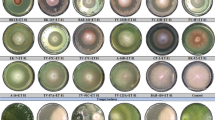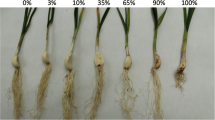Abstract
Lack of effective chemicals impedes control of Fusarium dry rot of stored potato tubers destined for processed and table stock use. Biological control of dry rot incited byGibberella pulicaris (anamorph=Fusarium sambucinum) has been demonstrated in laboratory studies but not in commercial storage environments. Several Gram-negative bacterial strains that were efficacious and amenable to production in liquid culture in laboratory studies were selected for pilot studies in Idaho and for bin trials at commercial storage houses in Idaho and North Dakota. In the first year of pilot studies,Pseudomonas fluorescens S22:T:04 (≈1 x 108 cfu/ml) decreased dry rot caused byG. pulicaris by 19% when coinoculated with the pathogen compared to controls and to the fungicide thiabendazole (TBZ) applied at label rates. In second year pilot studies,P. fluorescens P22:Y:05 andEnterobacter cloacae S11:T:07 (≈4 x 108 cfu/ml) reduced the severity of disease incited byG. pulicaris (25% and 17% average disease decrease, respectively) when antagonists were applied after pathogen inoculum. Treatment effects on dry rot that developed from inoculation withNectria haematococca (anamorph=Fusariumsolani var.coeruleum) were variable and influenced by interactions between antagonists, a wetting agent, and TBZ. In commercial storage bin trials,E. cloacae S11:T:07 reduced naturally occurring levels of dry rot by an average of 21% compared to 14% for TBZ, demonstrating that this antagonist was effective when produced using a liquid culture medium and methodology that approximates commercial practices for producing biomass.
Similar content being viewed by others
Literature Cited
Box, G.E.P., W.G. Hunter, and J.S. Hunter. 1978. Statistics for Experiments. An Introduction to Design, Data Analysis, and Model Building. John Wiley & sons, New York. 653 pp.
Boyd, A.E.W. 1972. Potato storage diseases. Rev Plant Pathol 51:297–321.
Bull, C.T., J.P. Stack, and J.L. Smilanick. 1997.Pseudomonas syringae strains ESC-10 and ESC-11 survive in wounds on citrus and control green and blue molds of citrus. Biol Control 8:81–88.
Cappellini, R.A., M.J. Ceponis, J.M. Wells, and G.W. Lightner. 1984. Disorders in potato shipments to the New York Market, 1972–1980. Plant Dis 68:1018–1020.
Carnegie, S.F., A.D. Ruthven, D.A. Lindsay, and T.D. Hall. 1990. Effects of fungicides applied to seed potato tubers at harvest or after grading on fungal storage diseases and plant development. Ann Appl Biol 116:61–72.
Chalutz, E. and S. Droby. 1998. Biological control of postharvest diseases. Pages 157–170.In: Plant-Microbe Interactions and Biological Control (G.J. Boland and L.D. Kuykendall, eds.). Marcel Dekker, Inc., New York.
Chelkowski, J. 1989. Toxinogenicity ofFusarium species causing dry rot of potato tubers. Pages 435–440.In: Fusarium Mycotoxins, Taxonomy and Pathogenicity (J. Chelkowski, ed.). Elsevier Publishing Co., New York.
Desjardins, A.E., E.A. Christ-Harned, S.P. McCormick, and G.A. Secor. 1993. Population structure and genetic analysis of field resistance to thiabendazole inGibberella pulicaris from potato tubers. Phytopathology 83:164–170.
Desjardins, A.E. and R.D. Plattner. 1989. Trichothecene toxin production by strains ofGibberella pulicaris (Fusarium sambucinum) in liquid culture and in potato tubers. J Agric Food Chem 37:388–392.
Droby, S., R. Hofstein, C.L. Wilson, M. Wisniewski, B. Fridlender, L. Cohen, B. Weiss, A. Daus, D. Timar, and E. Chalutz. 1993. Pilot testing ofPichia guilliermondii: a biocontrol agent of postharvest diseases of citrus fruit. Biol Control 3:47–52.
Duffy, B.G. and G. Défago. 1997. Zinc improves biocontrol of Fusarium crown and root rot of tomato byPseudomonas fluorescens and represses the production of pathogen metabolites inhibitory to bacterial antibiotic biosynthesis. Phytopathology 87:1250–1257.
Ei-Ghaouth, A. 1997. Biologically-based alternatives to synthetic fungicides for the control of postharvest diseases. J Industrial Microbiol 19:160–162.
Fravel, D.R. and R.P. Larkin. 1996. Availability and application of biocontrol products. Biol and Cultural Tests 11:1–7.
Hanson, L.E., S.J. Schwager, and R. Loria. 1996. Sensitivity to thiabendazole inFusarium species associated with dry rot of potato. Phytopathology 86:378–384.
Jackson, M.A. and D.A. Schisler. 1992. The composition and attributes ofColletotrichum truncatum spores are altered by the nutritional environment. Appl Environ Microbiol 58:2260–2265.
Janisiewicz, W.J. 1998. Biocontrol of postharvest diseases of temperate fruits: challenges and opportunities. Pages 171–198.In: Plant-Microbe Interactions and Biological Control (G.J. Boland and L.D. Kuykendall, eds.). Marcel Dekker, Inc., New York.
Kiewnick, S. and B.J. Jacobsen. 1997. Controlof Rhizoctonia black scurf andFusarium dry rot in potatoes with fungicides and antagonistic bacteria. Phytopathology 87:S51.
Kawchuk, L.M., J.D. Holley, D.R. Lynch, and R.M. Clear. 1994. Resistance to thiabendazole and thiophanate-methyl in Canadian isolates ofFusarium sambucinum andHelminthosporium solani. Am Potato J 71:185–192.
Leach, S.S. and R.E. Webb. 1981. Resistance of selected potato cultivars and clones to Fusarium dry rot. Phytopathology 71:623–629.
Murdoch, A.W. and R.K.S. Wood. 1972. Controlof Fusarium solani rot of potato tubers with fungicides. Ann Appl Biol 72:53–62.
Niemira, B.A., R. Hammerschmidt, and G.R. Safir. 1996. Postharvest suppression of potato dry rot (Fusarium sambucinum) in prenuclear minitubers by arbuscular mycorrhizal fungal inoculum. Am Potato J 73:509–515.
Pawlak, A., J. Pavek, and D.L. Corsini. 1987. Resistance to storage diseases in breeding stocks. Pages 96–98In: The Production of New Potato Varieties: Technological Advances (G.J. Jellis and D.E. Richardson, eds.). Cambridge University Press, New York.
Ranganna, B., A.C. Kushalappa, and G.S.V. Raghavan. 1997. Ultraviolet irradiance to control dry rot and soft rot of potato in storage. Can J Plant Pathol 19:30–35.
Schisler, D.A., K.D. Burkhead, P.J. Slininger, and R.J. Bothast. 1998. Selection, characterization and use of microbial antagonists for the control of Fusarium dry rot of potatoes. Pages 199–222.In: Plant-Microbe Interactions and Biological Control (G.J. Boland and L.D. Kuykendall, eds.). Marcel Dekker, Inc., New York.
Schisler, D.A., M.A. Jackson, and R.J. Bothast. 1991. Influence of nutrition during conidiation ofColletotrichum truncatum on conidial germination and efficacy in inciting disease inSesbania exaltata. Phytopathology 81: 587–590.
Schisler, D.A., C.P. Kurtzman, R.J. Bothast, and P.J. Slininger. 1995. Evaluation of yeasts for biological control of Fusarium dry rot of potatoes. Am Potato J 72:339–353.
Schisler, D.A. and P.J. Slininger. 1994. Selection and performance of bacterial strains for biologically controlling Fusarium dry rot of potatoes incited byGibberella pulicaris. Plant Dis 78:251–255.
Schisler, D.A. and P.J. Slininger. 1997. Microbial selection strategies that enhance the likelihood of developing commercial biological control products. J Indust Micro Biotech 19:172–179.
Schisler, D.A., P.J. Slininger, and R.J. Bothast. 1997. Effects of antagonist cell concentration and two-strain mixtures of biological control of Fusarium dry rot of potatoes. Phytopathology 87:177–183.
Secor, G.A., D. Rodriguez, J. Rodriguez, and N.C. Gudmestad. 1994. Distribution and incidence of benzimidazole-resistantFusarium sambucinum andHelminthosporium solani isolated from potato in North America. 1994 BCPC Monograph No 60: Fungicide Resistance, 271–274.
Senter, L.H., D.R. Sanson, D.G. Corley, M.S. Tempesta, A.A. Rottinghaus, and G.E. Rottinghaus. 1991. Cytotoxicity of trichothecene mycotoxins isolated fromFusarium sporotrichioides (MC-72083) andFusarium sambucinum in baby hamster kidney (BHK-21) cells. Mycopathologia 113:127–131.
Slininger, P.J., D.A. Schisler, and R.J. Bothast. 1994. Two-dimensional liquid culture focusing: a method of selecting commercially promising microbial isolates with demonstrated biological control capability. Pages 29–32.In: Improving Plant Productivity with Rhizosphere Bacteria. 3rd International Workshop on Plant Growth-Promoting Rhizobacteria, Adelaide, S. Australia (M.H. Ryder, P.M. Stephens and G.D. Bowen, eds). Graphic Services, Adelaide, Australia. CSIRO Division of Soils:Glen Osmond.
Slininger, P.J., D.A. Schisler, and R.J. Bothast. 1996. Bacteria for the control of Fusarium dry rot to potatoes. United States Patent 5, 552,315.
Slininger, P.J., J.E. Van Cauwenberge, R.J. Bothast, D.M. Weller, L.S. Thomashow, and R.J. Cook. 1996. Effect of growth culture physiological state, metabolites, and formulation on the viability, phytotoxicity, and efficacy of the take-all biocontrol agentPseudomonas fluorescens 2–79 stored encapsulated on wheat seeds. Appl Microbiol Biotechnol 45:391–398.
Tivoli, B., A. Deltour, D. Molet, P. Bedin, and B. Jouan. 1986. Mise en évidence de souches deFusarium roseum var.sambucinum resistantes au thiabendazole, isolées à partir de tubercules de pomme de terre. Agronomie 6:219–224.
Wastie, R.L., H.E. Stewart, and J. Brown. 1989. Comparative susceptibility of some potato cultivars to dry rot caused byFusarium sulphureum andF. solani var.coeruleum. Potato Res 32:49–55.
Zidack, N.K., P.A. Backman, and J.J. Shaw. 1992. Promotion of bacterial infection of leaves by an organosilicone surfactant: implications for biological weed control. Biol Control 2:111–117.
Author information
Authors and Affiliations
Corresponding author
Rights and permissions
About this article
Cite this article
Schisler, D.A., Slininger, P.J., Kleinkopf, G. et al. Biological control of fusarium dry rot of potato tubers under commercial storage conditions. Am. J. Pot Res 77, 29–40 (2000). https://doi.org/10.1007/BF02853659
Accepted:
Issue Date:
DOI: https://doi.org/10.1007/BF02853659




